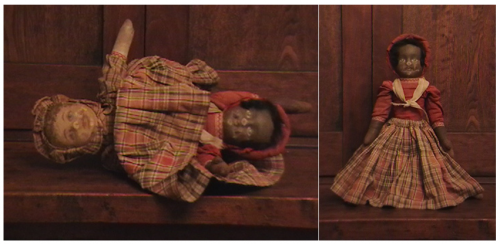Lisa Hix has written a really nice story, “Why Black Dolls Matter,” for Collectors Weekly. The history of the topsy-turvy doll really caught my interest. The one below is characteristic. Believed to be from the 1870s, it is the head and torso of a black and a white doll, sewed together in the middle with a long skirt. The doll can be flipped from one side to the other.
The general consensus seems to be that these dolls were primarily for enslaved children, but the purpose of the dolls isn’t clearly understood.
Hix quotes one of the founders of the National Black Doll Museum, Debra Britt, who says that the dolls enabled enslave children to have something forbidden: a doll that looked like them. “When the slave master was gone,” she explained, “the kids would have the black side, but when the slave master was around, they would have the white side.”
At wikipedia, though, the entry for the dolls cites the author of American Folk Dolls, who makes the opposite claim.
It has recently been suggested that these dolls were often made for Black children who desired a forbidden white doll (a baby like the ones their mothers cared for); they would flip the doll to the black side when an overseer passed them at play.
Kimberly Wallace-Sanders, author of Mammy: A Century of Race, Gender, and Southern Memory, suggests that the dolls might not have been disallowed at all. Since enslaved black women often cared for their own children and the children of their white captors, perhaps the doll was designed to socialize young enslaved girls into their future roles as mothers to children of both races. According to Historical Folk Toys, the black doll sometimes was dressed in a headscarf and the white doll in antebellum-style dress, supporting Wallace-Sanders’ theory that the idea was to socialize girls into their role.
And, of course, we have even less of an idea of how the children themselves thought of these dolls or where their imagination led them.
Cross-posted at Pacific Standard.
Lisa Wade, PhD is an Associate Professor at Tulane University. She is the author of American Hookup, a book about college sexual culture; a textbook about gender; and a forthcoming introductory text: Terrible Magnificent Sociology. You can follow her on Twitter and Instagram.

Comments 11
Bill R — November 19, 2014
Takes anatomically incorrect to a new level...
Lex Luthor — November 19, 2014
I had one as a kid that was Snow White on one end and the
witch/stepmother on the other. I would flip them back and forth to do
each one's dialogue. Sometimes they fought. I suppose you could use this
doll the same way, to enact little back and forth exchanges that model
interactions between black and white women or girls. (It's not clear whether the
doll is a child or an adult from the picture.)
TreeGazer — November 20, 2014
Is there evidence that the dolls belonged to slave children? I am surprised that slaves would have such a nice doll - and that enough of them would have these nice dolls that several have survived through the years. I would have expected these dolls to belong to white children - since black women were an integral part of their upbringing in the South, it's not surprising that they would incorporate it into their play.
I too had a topsy turvy doll as a child that belonged to my grandmother - however it was of little red riding hood on one side, and the grandma and wolf on the other side. Unlike the suggestion that slave children used the topsy turvy doll to either hide the white side or the black side - which seems incredibly unlikely since it seems like it would be so easy to get caught - and since there doesn't seem to be agreement as to which side they'd be hiding anyway - it seems far more likely that a child would use it to incorporate both sides into their play, similar to the Red Riding Hood or Snow White dolls.
Ovaltine — November 21, 2014
I've been collecting dolls for decades and I've never heard of these type of dolls being used to "hide" anything. In addition to being homemade, these types of dolls were also commercially manufactured and available at stores, so I don't think anyone could trick anyone with this type of thing. If true, I'd like to have more information about it because that's really interesting.
Sunday Morning Medicine | Nursing Clio — November 23, 2014
[…] Theories of the first topsy-turvy dolls. […]
Kathy Mitchell — July 4, 2022
I have a topsy turvey doll that was my grandmother’s three times removed that we believe was made in the late 1800s. It isn’t in great shape but everything is original, uncut he quilt it is wrapped in. I am looking for a good place to rehome it.
Kathy Mitchell — July 4, 2022
Includes the quilt….auto correct got me again. I can send pics to those who have a legitimate need.
What We Can Learn by Preserving Topsy-Turvy Dolls - WorthPoint — May 9, 2023
[…] plantations of the early 19th century. Handmade by enslaved African American mothers, the dolls may have helped socialize the children into future roles as caretakers of their own children and the children of White plantation […]
Sebastien — June 21, 2024
a lot of the theories of the topsy turvy dolls I have seen, seem to think these originated in North America, when there is ample evidence of these being also present in South America and the Caribbean during the same time period as they appear in the US. They were definitely found in Cuba in the mid 1800s.
I think the scholarship on these is very limited and contradictory.
ch talha yaseen — January 14, 2025
good